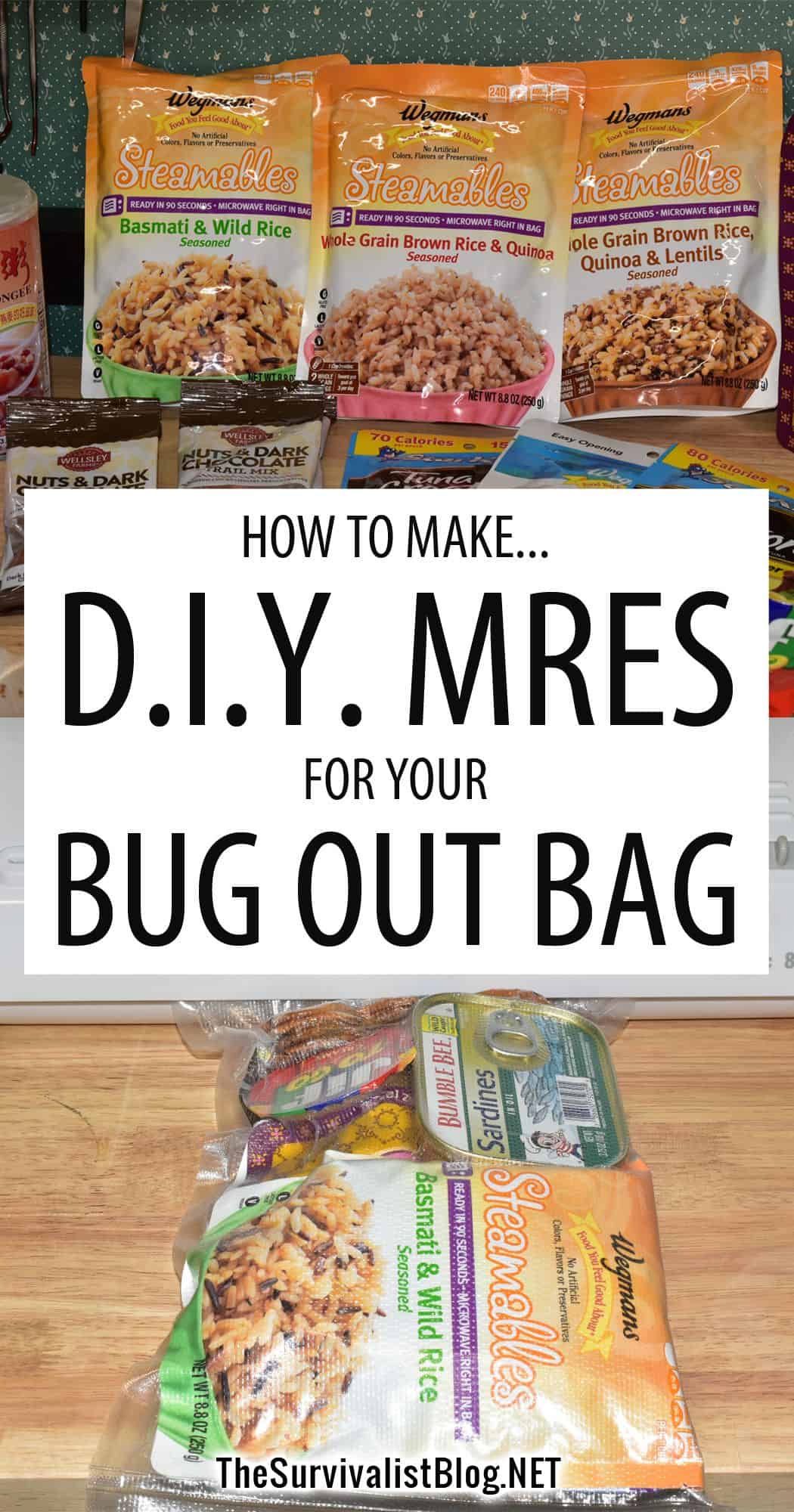How to Make DIY MREs for Your Bug out Bag
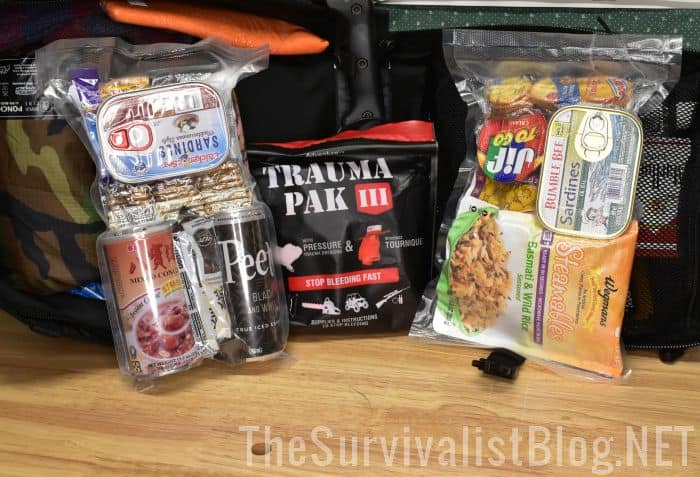
Preparing and packaging ready to eat meals is well worth learning for every prepper. While useful and a central part of most bug out plans, commercially available MREs can get quite pricey and may not meet the specialized dietary requirements of all family members.
Finally, newly packaged MREs can be hard to find. Many vendors deceptively sell them at or near their expiration date.
Armies have long used MREs. Although not in the sophisticated form they come today, even Roman soldiers had hardtack biscuits to see them through. Modern armies have marched and fought on meals ranging from canned to freeze-dried.
Governments employ the most modern technologies to make sure the meals are calorie packed, palatable, suit the requirements of various groups (e.g. gluten-free or sugar-free), and are safe to eat.
These days, the chief complaint is that MREs can be boring. The armed forces creators of MREs have an ongoing challenge to produce meals good enough for soldiers to eat every day. When people are on the move and expending energy, they need to keep a steady calorie intake otherwise their performance will suffer and they will lose weight.
When you make your own MREs, you can include food you like to eat across all food groups, and maintain a palatable and balanced diet. Remember, design your MREs for emergencies when you don’t have access to fresh food.
MREs for Long Term Consumption?
MREs are not ideal for the long-term. It may appeal to you to have a “simply add water” dinner while bugged out. But remember, you are paying a premium for these meals. Normal bug out meal plans should use your long-term food, not short-term quick dinners.
Just because manufacturers package meals with pretty pictures of mountains or forests, advertise that it lasts for up to 25 years, and campers/hikers love it doesn’t mean you have to buy it. Calorie for calorie, pre-packed MREs are expensive!
How many people who have bought cases of MREs have actually opened any and tasted them? How do they know they are going to be happy eating said ‘stuff’ in the future, day in and day out?
Do you need food that lasts for 25 years? Unlikely. Will your MREs last for 25 years? No! Let’s be brutally honest, stored under ideal conditions, most MREs last between 3 and 5 years. Some components may last longer others less. But in real-life, conditions are seldom ideal.
The hotter it is, the more humidity the environment is, and the more severe the temperature changes all shorten the life of stored food. This perfectly describes most people’s bug out bags (BOBs).
Most people want MREs at the ready in case of hurricanes, snowstorms, wildfires and man-made disasters.
We all know roughly when hurricane or fire season starts, so we can plan ahead. The potential for societal disasters is also on the increase. How many people in the last year have had to evacuate because of local riots? It’s not just weather that can send you running!
 MREs packed for bug out bag: sardines can, instant rice, soda can, crackers and more
MREs packed for bug out bag: sardines can, instant rice, soda can, crackers and moreIdeally, we should have MREs packed in BOB and ready to go in case of any emergency, or ready at your bug out location (BOL) a few months in advance. The MREs only need to last about a year. If you do not use them for an emergency, then use them on a camping or hunting trip and rotate new ones for the next season.
This way you can keep improving ingredients and flavors. You will then prepare MREs that best suit your dietary requirements–gluten-free, dairy-free, nut-free, vegetarian, or vegan as your needs grow and change.
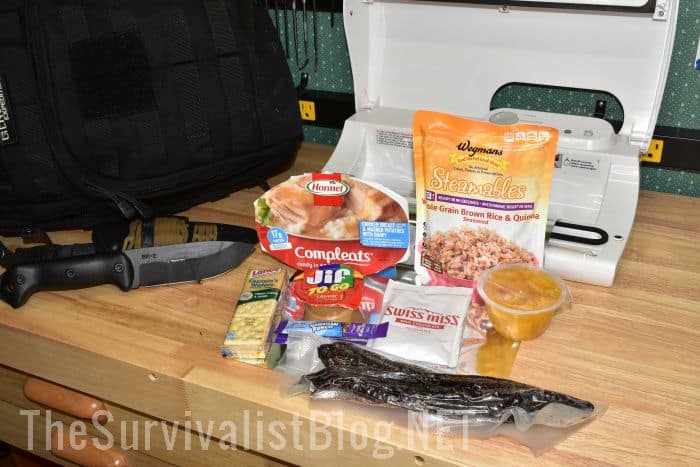 meat and potatoes, crackers, dried sausage, hot cocoa mix, brown rice
meat and potatoes, crackers, dried sausage, hot cocoa mix, brown riceConsidering MRE Weight
One of the complaints about MREs is that they are heavy. Try carrying two weeks’ of food in a backpack. That’s 3 meals a day, times 14 days. 42 meals, right? Are you seriously going to heft that in a backpack?
Before you go online to check out costly dehydrated meals or military MREs, visit your local supermarket to see what you can get there.
There are common dehydrated foods like mashed potatoes, noodles, and quick-cooking rice that have proven themselves popular and tasty over decades. These are meals or meal components that you can easily and inexpensively put together yourself.
Pros of MRE Foods
Let’s take a quick look at foods that you can add to your own “home-made” MREs:
- Products with a shelf life of at least 8 months
- Items that are lightweight and compact
- Prefer pouches to cans or paper cups
- Easy to prepare
- Just add boiling water
- Heat and eat
- Open and eat
- Meals able to eaten cold
Remember that you may not be able to boil water, or it may not be safe to start a fire when bugging out.
What Should Go Into My MRE?
A complete MRE needs a snack, main meal, dessert, and a beverage. Watch here to see how this Alaska granny put together her own:
Even though you are designing your MREs for short-term emergencies, you will still benefit by variety, calorie count, and nutritional balance.
You fully control variety in your meals. Avoid packing one style of MREs. Even over a few days, food fatigue can develop. Try packing meals that cover a variety of flavors and cuisines.
Your ingredients should have a complete nutritional profile for each meal.
Assuming 1,200 calories per MRE designed for the physical rigors of a bug out, try to mix and match your components to meet the following calorie/gram mixes:
- Total Calories: 1200
- Carbohydrates: 612 calories – 153 grams
- Protein: 216 calories – 54 grams
- Fat: 396 calories – 44 grams
These numbers are only guidance. It may be hard to hit the goals exactly. Do the best that you can with the foods that are available to you.
Use this plan as a starting point. The average daily calorie count for adult females is 2,400, and 3,000 for males. This figure is slightly higher than the averages generally quoted. If you are doing physical work (which you probably will, you need to consume more calories.
The Army gives soldiers 4,200 calories per day, but the problem is that the soldiers rarely eat everything in their MREs. The result is a reduction in calories and weight loss. The research into improving MREs for the forces is ongoing.
With your own bug out MREs, you have the advantage of setting your own calorie counts, and choosing foods that you enjoy!
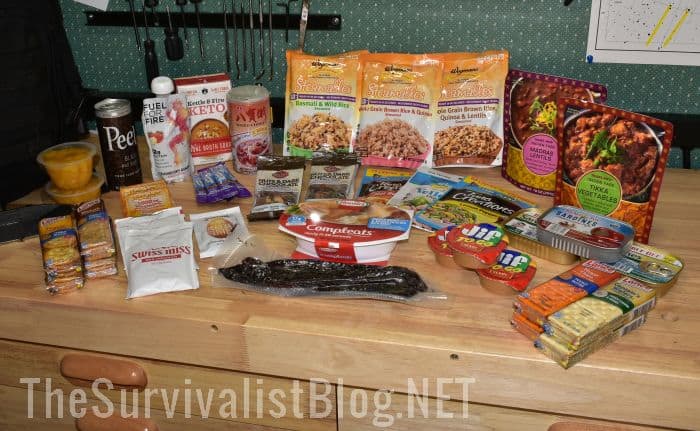
DIY MREs from Your Stockpile
To build your own MREs, there will be some foods that you can pick from your stockpile. These include foods and ingredients with long shelf-lives that you have already stored.
Be selective with your choices. MREs need to be instant or easy to prepare foods. This means only 1 to 2 minutes to heat or prep.
For example, instead of dried beans, pack instant rice, freeze-dried mashed potatoes, couscous, etc. Include anything that is calorie-rich, quick to prepare, and you love to eat.
Check the Local Supermarket
Before you go online and check out costly prepper food, visit to your local supermarket. See what you can get there. Most grocery stores have common heat-and-serve meals, and dehydrated foods like mashed potatoes. These all have proven themselves popular and tasty over decades.
Here are some common supermarket foods and their expected shelf-life. You will find many more once you search the supermarket shelves:
| Food | Shelf Life |
|---|---|
| Dehydrated meat flakes | 1 year |
| Freeze-dried meat: | 10 to 15 years |
| Instant mashed potatoes | 12 to 18 months |
| Instant packaged noodles | 8 months |
| Protein bars | 12 months |
| Crackers | 6 to 9 months |
| Powdered cheese | 3 to 5 years |
| Pemmican | 1 to 5 years |
| Tuna in a pouch | 3 years |
| Egg powder | Up to 25 years |
| Instant white Rice | 4 to 5 years (wild and brown rice don’t last as long–around 8 months) |
| Couscous | 6 months to a year |
| Hard candies | 12 months |
| Jellied candies/caramel | 6 to 9 months |
| Dark chocolate | 12 to 24 months |
| Milk and white chocolate: | 8 to 10 months (there are even ones that don’t melt in warm weather) |
| Chocolate mousse | 12 months |
| Milk powder | 2 to 10 years depending on the type |
| Premixed coffee sachets | 6 months |
| Instant Coffee sachets | 2 to 20 years |
| Teabags | 18 to 24 months |
| Hot chocolate sachets | 6 to 12 months |
| Juice powder | 3 years |
| Trail mix | 6 months |
| Jerky | 1 year (commercially packaged) 1 to 2 months if homemade |
| Applesauce pouches | 12 months |
| Yogurt pouches | 13 months |
| Salt | 5 years (additives may deteriorate, but pure sea salt should last indefinitely) |
| Sugar | 2 years – although it can last much longer |
| Dried spices/herbs | 1 to 2 years |
Use Your Dehydrator
It’s not necessary to buy a dehydrator to put together MREs, but if you have an abundance of fruits and vegetables and you want to save a little money, then it may be worth the investment.
You can dehydrate vegetables, meat, and fruit as additions to meals. With a dehydrator, you can also prepare fruit leather or dry out fruit like cranberries, raisins, sultanas, peaches, and apple rings.
YouTube is filled with dehydrated MRE examples. Here is one of the best examples, the author adds to the flavor and calorie content with gravy powder:
Canned Meals
Canned foods are heavy, however they can be complete meals and calorically dense. While they are best for bug in situations, you can easily heat them in a pot of warm water, then eaten straight from the can. As a bonus, there is minimal packaging to dispose of, and the can may be reused.
Many nations used canned and off-the-shelf goods for their military rations. These days, however, the trend is towards freeze-dried food.
Freeze-drying Food
I would say purchasing a freeze drier is sensible if you have a homestead and loads of vegetables, meat, and fruit to process. If you live in a city in a small apartment, then your best bet is finding suitable goods for your MREs from the local supermarket.
If a freeze-drier is for you, then GREAT! Load up on produce, meats, and complete meals. Harvestright brand freeze-driers have a loyal following https://harvestright.com/
Watch this video to see how to set up your freeze drier:
… and this one:
…explains how to go about freeze-drying your harvest.
Some items don’t rehydrate well–for example, carrots, beet, and parsnips; most root vegetables, but they will freeze-dry well. Should you choose to dehydrate these, they have to be ground up into a powder to rehydrate successfully.
Building a Better MRE
Now that you have scoured your stockpile, grocery store, and online outlets, it’s time to put together meals.
MREs are only limited by calories, shelf-life, and your imagination. I included a few full meals below, but these are only starting points. Feel free to add and subtract according to your tastes!
Breakfast and Snacks “On The Go”
- Can of congee (rice porridge)
- Canned coffee or instant
- Protein smoothie
- Almond butter
- Peanut butter Single
- Snack crackers
- Trail mix
- Electrolyte drink mixer (EmergenC)
- Fruit punch packet
- Total Calories 1,000
Heat-and-Eat Meal 1: “Hungry Prepper” Freeze-Dried Meat and Potatoes
- Freeze-dried beef and vegetables with gravy
- Instant mashed potatoes
- Brownie (50g = 233)
- Instant coffee\cappuccino
- Crackers and cheese
- Protein bar
- Total Calories 1300 (This is over the meals suggestion limit of 1200 calories, so maybe reduce the portion size for the entrée and rice or mash, or insert a smaller nut bar into the pack)
Heat-and-Eat Meal 2: Light Freeze-Dried Dinner
- Freeze-dried lamb and vegetables
- Instant rice
- Candy bar (e.g. mini snickers)
- Tea
- Mixed nuts
- Total Calories 1000 calories
Ready to Eat Meal 3: International Dinner
- Basmati and wild rice
- Indian madras Lentils
- Sardines
- Peanut butter single
- Fruit cup
- Trail mix
- Peanut butter crackers
- Hot chocolate packet
- Fruit punch packet
- Total Calories: 1300
Heat-and-Eat Meal 4: Traditional American Dinner (Heavy on the Carbs)
- Hormel chicken and mashed potatoes
- Rice and quinoa
- Biltong or jerky
- Fruit cup
- Cheese crackers
- Hot chocolate packet
- Fruit punch packet
- Total Calories: 1400
Heat-and-Eat Meal 5: High Protein Lunch
- Rice and quinoa
- Tuna packets (2)
- Keto bone broth
- Sardines in oil
- Cheese crackers
- Trail mix
- Electrolyte mix
- Hot chocolate packet
- Fruit punch packet
- Total Calories: 1300
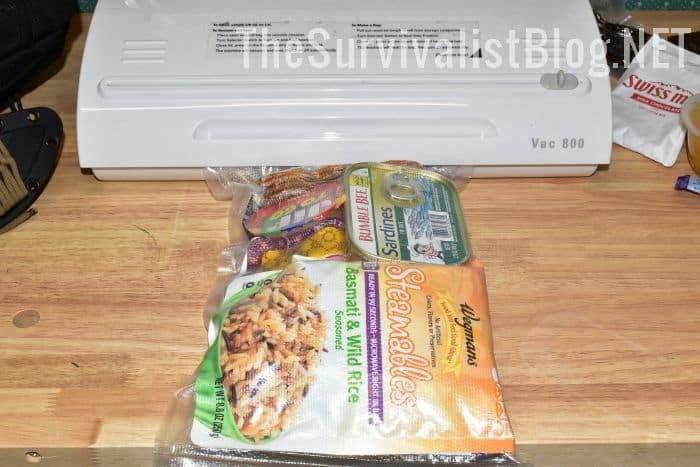
Packaging Your MREs
Packaging will be essential for your MREs as you don’t want them to wander all around your BOB. You can keep the components in a Ziplock bag, however they will shift within the bag, and you may end up damaging some of the contents.
A better option is to use your home vacuum sealing equipment. I even recommend adding desiccant packs to keep your MRE moisture-free. If you don’t have a vacuum sealing machine, you can find them online from anywhere between $45 and $400.
The higher-end ones are stainless steel and commercial grade. The Megawise is moderately priced and provides a reliable product.
When vacuum sealing, it’s best to seal snacks, entrees, and desserts separately, and then seal the entire meal in a single vacuum bag for full protection. You don’t want a packet leaking and contaminating your other food items. Mylar bags are an excellent choice.
This video shows MREs prepared from readily available supermarket foods:
…as does this one:
Heating MREs
While it’s best to plan MREs that require no cooking, there is nothing better than a warm meal to lift your spirits. However, what will you cook with?
During a bug out, you won’t have electricity to boil a pot of water nor will you have a microwave. You’ll need to rely on a campfire or camp stove to heat your MRE.
If you are on the move, then lightweight freeze-dried foods are a good choice. Simply pour in some boiling water to rehydrate.
If you expect not having a means to, or it may not be safe to heat your MRE, then prepare MREs that you can eat cold like pemmican, trail mix, granola bars, and pasta in a pouch.
Finishing Touches
Now you have your MREs planned and packaged, don’t forget a couple of niceties for your meal.
A wooden spoon is better than a fork which could poke a hole in your pouched food. Individually packed towelettes will help you clean up and feel fresh after eating, so include these before sealing your MRE.
Wrapping Up Homemade MREs
Bug out planning is filled with a lot of ground to cover. This includes bags, tools, water filtration, shelter making, security, medical, and food. While we can make it several days without food, by the end of a foodless bug out, no one will be happy.
A hot meal during a long bug out can lift your spirits like little else. A full belly can bring a sense of normalcy to an otherwise stressful situation. By packaging your own MREs, you can ensure that you have lightweight food that you will look forward to, will fill you up, and won’t break the bank.
Give these “recipes” a try, and let us know of any other custom MREs you’ve made in the comments below.
